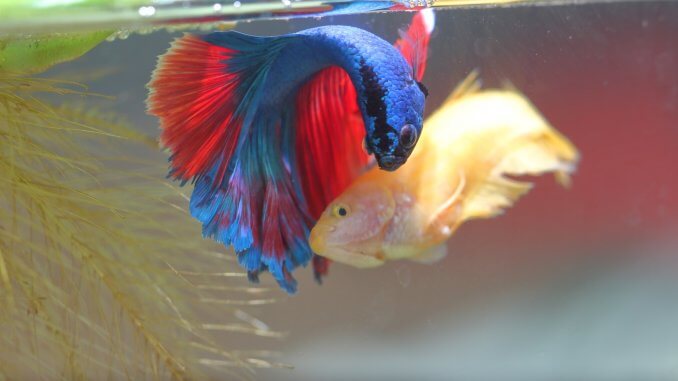
Beautiful, majestic, and easy to care for, betta fish are hugely popular among fish keepers. Bettas come in a wide variety of colors and shapes. This species variance has mainly developed due to selective breeding.
This guide will teach you how to breed betta fish and will discuss key information including when the fish are ready to breed, how to set up a suitable breeding tank, and much more.
TABLE OF CONTENTS
Step One: Set up a Tank
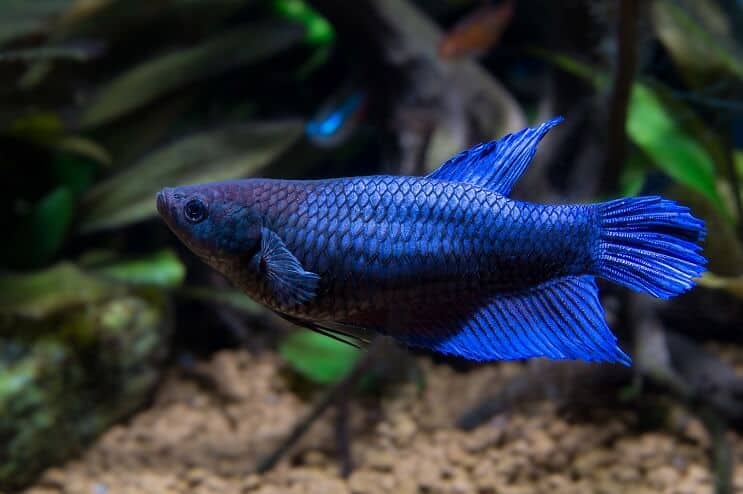
The very first step to breeding bettas is to set up a suitable breeding tank. A basic setup should include at least three tanks: the male betta’s tank, the female betta’s tank, and the breeding tank. You could also purchase an optional fourth tank for the fry to grow up in, but you may choose to just leave them in the breeding tank.
There are four main elements you should consider, when setting up a tank, to make sure the breeding goes smoothly: tank size, equipment, decorations, and safety.
Tank Size
The breeding tank should be at least 5 gallons in size. A 10-gallon tank is best, as it provides enough space for the bettas to hide from each other, if necessary, but won’t make it difficult for them to come together.
The breeding tank should be separate from both the male and female’s home tanks, and it’s best to keep the tank away from other aquariums.
The tank won’t need to be completely full, so 3 to 5 inches of water will be enough. If you can, keep the breeding tank in a quiet, private area.
Equipment
Betta breeding tanks are much more basic than regular tanks, and only need a few pieces of equipment. You’ll need a heater to keep the water at around 78°F. Whether or not you choose to use a filter is up to you. Be aware, however, that a strong water current can destroy the male’s bubble nest. Without a bubble nest, the female won’t lay eggs.
It’s also a good idea to use some clear plastic partitions to divide the tank and keep the male and female apart. This allows the pair to see each other without the male chasing or bullying the female.
Once you have the tank set up, you’ll need to let it cycle before adding your bettas. Cycling takes at least a week.
Decorations
Your breeding tank will need some decorations, but you shouldn’t overcrowd the tank. For instance, gravel or sand on the floor of the tank is a bad idea. Keep the floor of the tank bare. The eggs may settle in the gravel, or the male may not be able to find them.
For decorations, you’ll need:
- A hiding place — Male bettas are aggressive, especially during breeding. The female may need a break or somewhere to hide
- Something to float on the surface of the tank — Live plants, leaves, or even a styrofoam cup will give the male a place to build his bubble nest
- Live plants — Live plants aren’t completely necessary, but they add oxygen to the water and will give the newly hatched fry something to eat. Live plants provide the female bettas with good hiding places. Bettas prefer shade and privacy during breeding, so leaves can add needed shelter.
It’s best to keep decorations to a minimum. The breeding tank is only a temporary location, and you want the bettas to focus on each other.
Safety
Male bettas are aggressive. If you introduce the male and female too soon, the male may bully or even attack the female. This will leave your female betta exhausted and possibly even injured. An attack can result in a lack of eggs or, in a worst-case scenario, a dead betta fish.
Use a clear container or a plastic divider to keep the male and female apart until they’re ready to be introduced. Keep an eye on your bettas while they breed, and be ready to take the female out of the tank once the breeding is over.
Bettas like privacy, so bright light can discourage them from breeding. If possible, put a lid or cover over the tank while breeding betta fish. You’ll need to check on your bettas regularly.
Step Two: Choose Your Breeding Pair
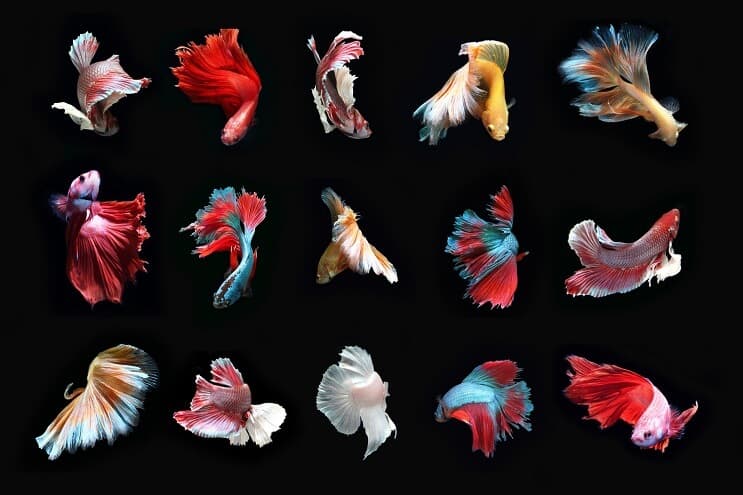
Now comes the fun part — choosing your breeding pair. Don’t just pick the first two bettas you see. It’s important to know what to look for in both males and females, which will give the best chance of healthy fry and happy parent bettas.
What to Look for In a Male Betta
Male bettas are known for their vibrant colors and long, flowing fins. In the wild, female bettas choose males based on their colors and the quality of their bubble nests.
In captivity, you can choose the color and style of a male betta that you’d like to breed. Here’s what you should look for:
- A healthy, energetic fish — The male betta will care for the eggs until they hatch, and he will need to be healthy and ready to deal with the stresses of courting and caring for his young
- Vibrant colors with long, impressive fins — Bright colors are best, and red is the most popular color
- The style of fin that you’d like the fry to have — For example, you may want to breed more combtail bettas. In that case, you’ll want a combtail male, preferably with very impressive fins
The male betta’s temperament should also be a factor when breeding betta fish. Overly aggressive bettas may make breeding more difficult, and may even injure the female.
What to Look for in a Female Betta
Courting and breeding are very stressful experiences for a female betta, so be sure to choose a strong and healthy female. Unlike males, color and fin length aren’t so important in females.
Here’s what you need to look for in a female betta:
- A healthy, energetic fish — Your female betta should be happy, with healthy coloring and no visible illnesses or injuries
- A fish with a good appetite — Make sure your female is eating well and not lethargic
- A female around the same size as the male — A female of equal size to the male, or smaller, makes a good match
Most importantly, you need to know whether or not your female betta is ready to breed — and whether she likes that particular male betta. This will be discussed in more detail later. First, you need to replicate the perfect breeding conditions.
Step Three: Condition Your Fish and Create a Breeding Environment
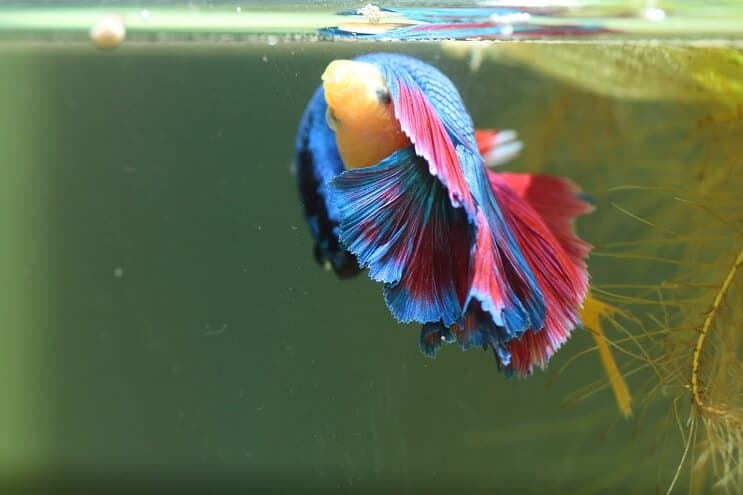
In the wild, water changes and other environmental factors tell a betta that it’s time to breed. In captivity, you need to replicate those conditions. It takes about two weeks to condition a pair of bettas.
At this point, neither of your bettas should be in the breeding tank. Putting your bettas into the breeding tank and introducing them to each other is one of the final steps of breeding.
Live food is the best way to condition your bettas for breeding. Frequent water changes are also a good idea.
Start by feeding your bettas high-quality, live food two to four times a day. Some foods you can try include:
- Bloodworms
- Small insects
- Daphnia
- Tubifex worms
You can even feed your bettas finely chopped meat. This diet gets your bettas used to the idea of breeding and keeps them strong and healthy. If you can’t use live food, frozen food will do.
Step Four: Introduce Your Breeding Pair
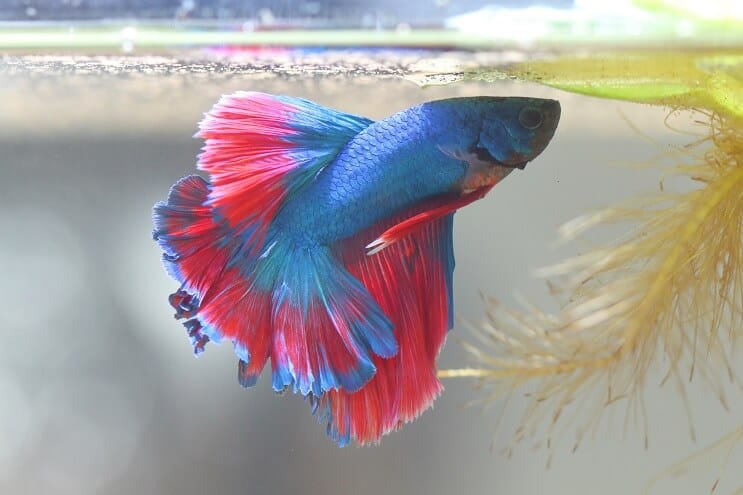
Once your fish are conditioned and you’ve set up the tank for breeding, it’s time for action. You should introduce the female betta to the breeding tank first, and then the male.
This is the tricky part of breeding betta fish — even if both bettas are excited and ready to breed, the introduction can go wrong if you aren’t careful.
Introducing the Female
The female needs to be added to the tank first and given around 30 minutes to settle in. Use a clear container or a plastic divider so that she has her own space. It’s important to use see-through dividers so that the male and female can see each other.
Introducing the Male
Once the female is comfortable in her part of the tank, you can add the male to his section and let him settle in. Keep the female and male separated.
The two bettas should notice each other immediately. The male’s color will darken and he will flare his fins, indicating that he’s interested in the female. The female will display interest in the male — her color will darken and she’ll display vertical stripes across her body. These stripes indicate that she’s ready to breed.
The male might bite at the divider in an attempt to reach the female. This is normal behavior. After showing off for a while, the male should rush off and build a bubble nest. It can take up to 24 hours for the male to build a bubble nest, and he’ll come back frequently to show off some more for the female. It’s important the nest is built before any breeding can take place.
The First Meeting
If the initial discovery goes well, and you’re confident that your bettas are interested in each other, you can remove the divider and let the male and female meet properly. After they meet, there’s a sequence of events that should happen to culminate in successful breeding. Keep a close eye on your bettas in case the male gets too aggressive.
- The female will swim over to the bubble nest to inspect it. If she’s pleased with the male’s efforts, the courtship will begin
- The male will begin to chase the female around the tank. This can go on for a few hours
- The pair will swim side by side, flaring their fins at each other. This is where the male can get aggressive — if the female doesn’t respond, he may bite and nip at her.
This behavior is a lead-up to the actual mating process. It can take a few hours or even a day or two. While your bettas are courting, you shouldn’t feed them.
Step Five: The Breeding
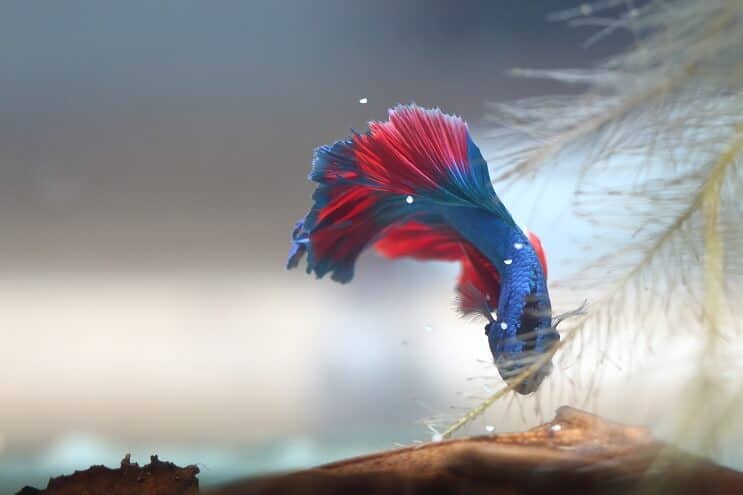
To breed, the male betta turns the female upside down and holds her close, so that he can fertilize the eggs as she lays them. The eggs sink to the bottom of the tank, and the male scoops them up and takes them to the bubble nest.
It often takes a few of these embraces before the female starts to lay eggs. It’s important to note that the female will likely lie on her side and look ill and lifeless while she’s laying the eggs. If you’re a first-time betta breeder, this might be worrying. Don’t worry, this is normal.
You can expect around 30–40 eggs to be laid, but some bettas can lay hundreds.
Step Six: Remove the Female
Once the mating is over and all the eggs are laid, the male should let go of the female and start busily taking the eggs to the bubble nest. Now it’s time to remove the female.
Courtship is an exhausting process, and there’s a chance that your female betta could have been injured. The male sometimes attacks the female after breeding, seeing her as a threat to the eggs. In fact, the male could be right — some females do eat their own eggs. The male is the one who cares for the eggs, so there’s no need for the female to stay in the tank.
Step Seven: Maintenance and Hatching
Male bettas are good fathers and care for their eggs until they hatch. The males may rearrange the bubble nests, or build new ones.
It’s important to keep the tank warm and humid. The best way to do this is by wrapping plastic wrap around the tank and keeping it in a warm environment.
You might notice your male eating a few eggs. Before you panic, remember that it’s unlikely that every single egg will have been fertilized, especially if there are hundreds. Your male betta could be eating unfertilized eggs. It’s best not to feed the male until the eggs have hatched.
After around 36 hours, the fry will start to wriggle out of their bubble nests. It’s too soon for them to hatch, and the male betta will catch them and put them back in the nest. During this time, the male betta will hang around beneath the bubble nest, keeping an eye on his young.
The betta fry should hatch after around four days. They will then be ready for their first feed. The male betta’s work is done. At this point, it’s best to take him out of the tank, as he might try and eat his children now that they’ve hatched.
Warning Signs to Watch Out For
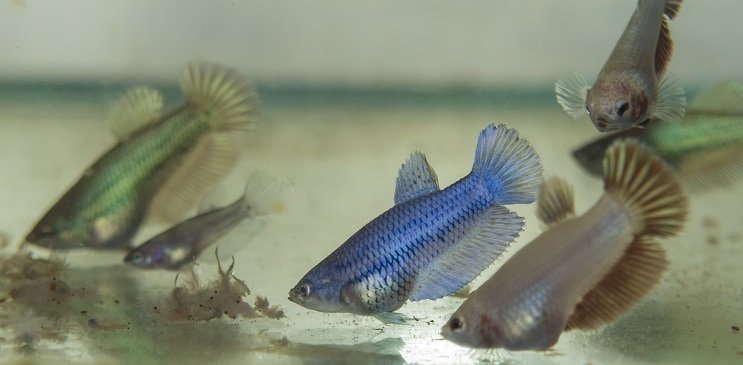
Breeding bettas can be tricky for first-time breeders. Simply tossing a male and female betta in a tank together and leaving them alone for a few days isn’t good enough — you could end up with a dead female and no eggs.
Here are a few warning signs that indicate that breeding betta fish isn’t going well.
- The female shows no interest in the male — Depending on the female’s personality, she could be quiet and shy, which doesn’t mean she isn’t interested in courtship. However, if your female betta doesn’t display the breeding marks on her body and tries to avoid the male, this means she either isn’t interested in the male or isn’t ready to breed. You should take her out and try with another female
- The female destroys the male’s bubble nest — Which means that she’s not happy with the nest. At this point, you’ll need to take her out and try again later with the same pair. If she destroys it a second time, the pair isn’t compatible. Try again with a different female or a different male, or a whole new pair
- The male is far too aggressive — While some aggression is normal during betta breeding, you mustn’t let it go too far. Male bettas can seriously injure or even kill female bettas. If the female doesn’t show any interest in breeding with the male, the male will grow more frustrated and aggressive. If you have any concerns at all, take the female out of the breeding tank
- The female is badly injured — If your female is desperately trying to hide and avoid the male or is visibly injured or bleeding, take her out of the tank
The Bottom Line
Breeding bettas is an exciting and rewarding process. As long as you’re careful with your bettas and do plenty of research, there’s no reason why you shouldn’t welcome a few dozen betta fry into your aquarium.
Breeding your own bettas is the best way to make sure you have healthy, happy, and beautiful fish.

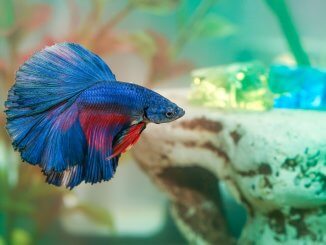
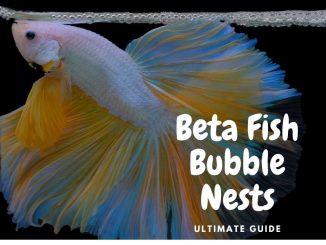
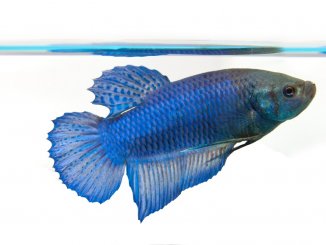

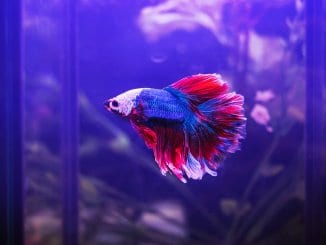

I would like to breed bettas
Great article – Thank you.
Followed the instructions you left and was successful (twice) but what I have noticed is that of all the offspring are female.
How old do they have to be before you can determine the sex of them
Yes indeed i have succesfully breed 3 diferent females 3 diferent hatches whit in a coupple weeks to a month of diference in d age of hatchlings
I have followed these steps, and it went great! The female and male are perfectly healthy and the female has layed 42 eggs. My friends are now having healthy betta babies, and I want to thank you for writing how to breed betta fish. Thank you, Have a great day/afternoon/night!
How many fry’s did you get and don’t we have to separate each fry since they will fight to death ?
No, they don’t have to be separated
About a month in .watch for sex and aggressiveNess . Separate males from females.then separate individualy as they get aggressive.
I have 4th batch of beta fry’s. I had 3k frys but it end up dying. I feed them daily infurisa, egg yolk and brine shrimp. I had 100 or less left. Can you please help me? Maybe any special procedure? please
HI Marilyn, are the water parameters where they are supposed to be? Has the tank fully cycled? Many thanks, Robert
Marilyn, avoid using egg yolk as a food for a very young fry.it tend to pollute water so quickly.
As this can cause death for your young fry.
Use live foods only for this early stage of fry life.
infurisa & Baby Brine Shrimp should do the trick.
Try to provide indian Almond leaf & dried banana leaf inside your tank for the fry. It generates Daphnia growth and act as food supply for small fry.
Hoped this helped.
I have had my bettas together now for about 20 hours. And they flare at eachother. The nest was made. They chase eachother. The female is showing all the signs necessary but they haven’t embraced yet. Should I take the female out and try in a couple days?
I’m back to try Betta breeding again. I did back in the early 2000s, with my best success a pair of metallic golds. They gave me over 400 fry, but only about 150 survived (live food source was a problem). Most of them turned out irridescent blues and greens – my entire fish club was raising my betta fry 🙂 This time I have a red koi plakat male and two koi females – waiting to see how the females grow up to decide on the pairing. Thanks for a great article on how to do it all!
My thing is….how do you keep the water clean for 4 months till they get big?
Small water changes are sometimes necessary to keep the water clean, but remember, with fry this small, it’s best to remove water with a very small airline tubing, where you can watch the intake point carefully, and avoid letting any of the babies get sucked in. Adding lots of live plants is very helpful as well, as plants do a fairly good job of cleaning the water to a small degree. Also, I have found that the larger the surface area of the water, more so than the depth, is very good for cleaner water.
thanks for this article, my female is full with eggs so after months we decided to breed her since she is not dropping any, will keep posted if things go well. thank
Hi, I don’t have access to fresh shrimp eggs (live food) so I’m wondering what can I use to substitute it?
I have access to frozen or dried products.
Thank you
You can buy bags of dried brine shrimp eggs (eBay) which will last for a over a year unhatched to hatch yourself, or also you can breed micro worms with a starter batch (either eBay or a fellow breeder may be willing to give you a small pouch to start off with)
I’m sure you can culture or grow other types if you look on the net, but these seem like the least messy/complicated to me…
I find the micro worms are easier as you don’t need special equipment (home made or store bought) and once you have it set up it only takes 2 days before you can start harvesting daily and will only need maintenance once every 2 weeks, while baby brine shrimp takes 2-3 days to hatch and will not continuously produce more, so you need to constantly have a new batch on the go to ensure you don’t run out.
Hatching brine shrimp requires the right salinity and constantly moving water at a certain temperature to ensure you get a decent hatch rate – you can diy a hatching bottle/jar/box or give an arm and a leg to buy specially made equipment, and food to keep the batch alive- YouTube has reviews and instructions for both. I find that having to remove the baby shrimp from the salt water while trying to avoid the shell casings slightly fiddley unless you use a baster and fine mesh (again you can buy on eBay just check the micron size before purchasing the mesh)
Micro worms require a takeaway box or bowl (plastic disposable ones will do), cling film or lid, oats and hot water (basically a small amount of plain thick porridge) and a pinch of yeast – again, YouTube will give detailed instructions but it is literally room temperature thick porridge in a bowl with the starter culture on top, sprinkled with a pinch of yeast and covered (air holes required), left at room temperature with light. I the worms climb the slides and onto the lid/clingfilm so you just run your finger/spoon/cottonbud along the edges to gather and dip it in the tank.
Excellent article! thanks!
Question please: after a female had laid eggs, when can she do it again next time? after a week i can see she has edds and wondering when can i introduce her again to the male.
We just had a successful round of breeding and had hundreds of frys. Our only mistake was not removing the male. We had them all happy this morning, but 8 hours later, zero fry =(. He ate them all. No sure if the only female is ready for breeding again
I put my female and male beta in a tank together and now they have a nest and they are laying eggs
Is aeration necessary for fry stage ?
my male betta hated my female and tried to kill her, shes ok now but shes still really fat with eggs is that normal?
I need help! My bettas are breeding in a community tank with other fish ? he has already put the eggs in the bubble but I don’t know if I can transfer the nest to a tank or if I should leave it alone..
Why do i must separate male betta as they start swimming freely? I tried bringing back the male to the tank becuase i want him to eat those mosquito larvae, he ate one fry and released it alive., Is it safe to keep the male betta with fry?
I have put my both male and female together, male had made bubble nest but suddenly overnight the tail of male fish start destroying. What may be the reason? Is there any remedy for this
Hi. I just want to ask, why my male is not making any bubble nest when he’s in the breeding tank. Even though he makes plenty on his permanent living tank.
i have a successful courtship, im almost to the part of removing the female and leaving the male. they were in a 25 gallon tank with 5 tetras a large plecko and 2 lochs. will the loch and plecko eat the fry? should i relocate the male and the babies instead using the water from the tank to a different container or just use a fry net inside the current tank?
Sometimes the stress of temp. change or moving around too much can cause the male to be discouraged. If the male is not interested in the female he won’t build one, or a more common reason in my case is if the male had a large bubble nest already made in his permanent tank, then it may take him a little bit to start a new one after being taken away from the old one. Hope this helped!
I just bought a nice healthy (large!) candy coi female betta, and the only male I own that is large enough to breed with her is a halfmoon doubletail betta. Does the female HAVE to be the same size or smaller than the male in order to breed both safely and successfully, or is it okay that the female is both fatter and slightly larger than the male? They seem to have a real interest in each other and I just wanna make sure it’s okay before I breed them! I would love to hear what any of you think.
I think its better to keep the female the same size or smaller. Once I tried a big white female and a smaller blue male, and the female killed him